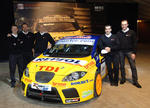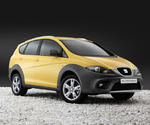
SEAT Press Release:
SEAT presents its first Diesel at a FIA World Touring Car Championship
In Sweden, Jordi Gené and Yvan Muller will drive a León WTCC equipped with a 280 hp TDI engine, stemming from the 170 hp 2.0 mounted in the León FR.
The next FIA World Touring Car Championship event will be a milestone for both SEAT and the FIA World Series. For the first time, a manufacturer’s Diesel car will line up at a FIA-organised official World Championship race.
SEAT will be rolling two TDI cars onto the
Scandinavian Raceway at Anderstorp on July 28/29, whose engine base derives from the 170 hp 2.0 TDI mounted in the León FR, as the culmination of a technological breakthrough that SEAT Sport engineers have been working on for the past few months. After a long stage of technical testing, the project will make its debut at the next WTCC meeting. The aim is to increase the team’s competitiveness at the World Championship and pave the way to winning the Manufacturers’ and Drivers’ titles.


Jordi Gené and Yvan Muller will be responsible for piloting these first two units in what will be one of the greatest challenges recently faced by SEAT Sport, and all thanks to the option provided by the World Championship rule book.
Jaime Puig, Director of SEAT Sport: “The regulations allow us to register a car equipped with a Diesel engine, and we were happy to rise to the challenge. We are satisfied with the testing results and believe the León TDI WTCC can become a competitive car in the mid and long term. For the moment it will only be driven by Jordi Gené, who has been responsible for its
development, and Yvan Muller. Gabriele Tarquini, Tiago Monteiro and Michel Jourdain will continue to drive the usual model.”
Benoit Bagur, SEAT Sport Chief Engineer: “Since the FIA made it possible to enter a Diesel engine in the competition, we started looking into the viability of the project, and it took off a few months ago. The basis for the engine is the 170 hp 2.0 mounted on the León FR. We kept the engine block and the cylinder head of the production model, but changed the turbo compressor and
gearbox. Furthermore, we had to alter the front part to house the intercooler and create new air intakes. The Diesel engine is 35 kilos heavier than the petrol engine, so we had to redistribute some weight. After satisfactory test results, we are eager to see its potential in actual racing conditions.”
Jordi Gené: “We have been working on this project for several months, and appreciate its great potential. I am looking forward to it because one of the aspects I most like about my job is the possibility of working on new car development, and even more so when they feature new technologies. We are facing a double handicap with the Diesel car. The first is that according to regulations, a Diesel car has to weigh 30
kilos more than with a petrol engine. The second is that the intercooler and the turbo are situated in front of the front axel, which makes weight distribution detrimental compared to a petrol car. But, as the León has the best chassis in the Championship and our engine torque will be much higher, I think that, in the mid-term and on certain tracks, we can be competitive.”
Yvan Muller: “I have done some testing with the Diesel engine, and the lap times are very similar to the petrol engine. It is a little slower in the corners because of the extra weight and there is more stress on the tyres, but it is a little bit quicker on the straights. The chassis of the SEAT León is one of the best, but the straight-line speed is too slow and now SEAT Sport has found a good solution to this problem. I raced a diesel-engined car at the Spa 24Hrs once, and I’m looking forward to racing the León for the first time in Sweden.”
SEAT Leon TDI WTCC Technical Data
BASE CAR
SEAT LeĂłn 2.0 TDI FR
ENGINE
- Turbocharged; 4-cylinder in line, transversally installed; distribution: two overhead camshafts, 16 valves.
- Displacement: 2000 cc.
- Bore x stroke: 81x95,5 mm.
- Maximum power: 280 bhp / 4000 rpm.
- Maximum torque: 450 nm / 2500 rpm.
- Lubrication: wet sump.
- Particle filter: DOW
TRANSMISSION
- Front-wheel drive; gearbox: Hewland 6-speed, sequential shift.
- Clutch: twin-plate.
- Differential: mechanical limited slip differential.
CHASSIS
- Front suspension: McPherson strut, coil springs, gas-filled dampers, anti-roll bar.
- Rear suspension: multi-link axel, coil springs, gas-filled dampers, anti-roll bar.
- Steering: power assisted rack and pinion.
BRAKES
- Not-assisted dual circuit system.
- Front brakes: 4-piston calipers, 332 mm steel ventilated discs.
- Rear brakes: 2-piston calipers, 280 mm steel discs.
DIMENSIONS
- Length: 4330 mm.
- Width: 1849 mm.
- Wheelbase: 2600 mm.
- Minimum weight: 1170kg (including driver).
Anderstorp Circuit
Located 160kms south-east of Gothenburg, in the Jönköping County region of southern Sweden, the circuit has hosted six Formula 1 Grand Prix (1973-’78) and is relatively flat and wide, with open grass run-off areas. It features three relatively long straights (one of which, the Flight Straight, takes its name from the fact that it is part of a runway) and long 90-and-above degree turns, several of which are banked. Unusually, the start/finish line is not located near the pits.
Circuit data
- Race: 2007 FIA WTCC Rounds 13/14
- Venue: Anderstrop, Sweden
- Lap distance: 4.025km
Timing
27/07
15.00 – 15.30: Test
28/07
09.00 – 09.30: Free Practice 1
11.30 – 12.00: Free Practice 2
15.30-16.00: Qualifying
29/07
09.00 – 09.15: Warm up
12.05: Race 1
14.35: Race 2
Pole Record: Nicola Larini (Alfa Romeo 156)1.39.064/146.26kph (06-09-03)
Lap Record: Nicola Larini (Alfa Romeo 156) 1.39.946/144.98kph (07-09-05)
Last Winners: Roberto Colciago and Nicola Larini (2003 FIA ETCC)
















